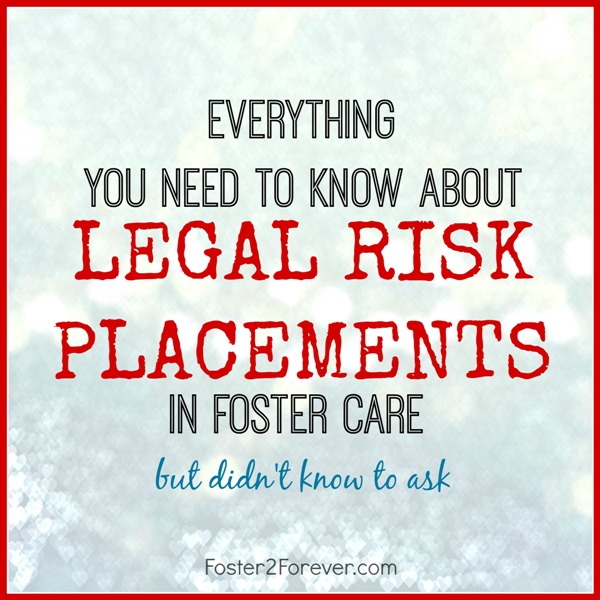Our home is a dual-licensed foster home meaning that we are licensed for both foster care and adoption; however, we are currently only open for legal risk placements. This week, our foster home worker sent us these FAQs on legal risk placements. Does this answer your questions or create more?
LEGAL RISK PLACEMENTS
Some Questions and Answers
A child is placed in an adoptive home when all rights of birth parents have been terminated. There are times when this cannot happen because of legal complications involving the termination. When this happens we may consider an adoptive placement with potential adoptive parents who are willing to take the risk that parental rights may not be terminated or who are willing to wait for this to happen no matter how long it takes.
1. What is a legal risk placement?
A legal risk placement is the placement of a child(ren) into an adoptive home prior to a final order terminating parental rights. OR, if termination of parental rights has taken place, and the biological parents have appealed the termination to an appeals court.
2. Why does the Texas Department of Protective and Regulatory Services utilize “legal risk” placements?
This is a good question because some would suggest that no child be placed for adoption until all potential legal obstacles have been cleared. TDPRS chooses to go ahead with a legal risk placement when the agency is reasonably confident that termination will occur. It has been our experience that the wait for all court action to be finalized has created devastating consequences to the children in our Conservatorship. In order to minimize the period of uncertainty in the child/ren’s life, TDPRS may proceed with a legal risk placement. The Department will do all it can to expedite (or, speed up) the legal process and to reduce the risks of the adoptive placement being overturned. Nevertheless, there can be no guarantees. The Department recognizes that, if something goes wrong, then the family and child may face heartbreak and emotional trauma. The Department is very cautious about utilizing legal risk placement prior to termination of parental rights. Therefore, the Department will not consider making a legal risk placement unless it believes it has a good, solid care for termination.
Legal risk placements usually occur when a child needs to be moved from a foster home near the time the parental rights are to be terminated. This move will only be made if it is our assessment that the child is ready to start bonding with the potential adoptive family.
3. What requirements must a family meet in order to be considered for a legal risk placement?
A family must be licensed as foster parents until termination of parental rights occurs and must follow all rules and regulations that apply to foster parents. The prospective adoptive family will need to be trained in CPR and First Aid prior to being licensed as foster parents.
The prospective adoptive family will have foster home worker who will visit the family once every two months and it will be important for the family to attend the six month review hearing (Chapter 18 Court Hearings) and the Permanency Planning Team meetings that affect the child placed in their home.
4. Should an attorney be consulted prior to entering into a legal risk placement?
The Department strongly recommends that a family consult an Attorney regarding legal risk placements. By consulting an attorney, the family will be able to obtain an assessment of the risks from a neutral source.
5. When are legal risk placements made?
A placement is considered to be a legal risk when:
A. parental rights have not been terminated;
B. a parent has appealed the judgment terminating parental rights;
C. a parent has taken action indicating that a termination judgment likely will be appealed.
6. What risks must a prospective adoptive family consider?
The greatest risk is that a prospective adoptive family will have to give up a child. There are other factors a prospective adoptive family must consider. For example, the family might have to provide continuing visits between the child and birth parents until termination takes place. In addition, the prospective adoptive family will not be able to tell the child that they are their adoptive family until parental rights have been terminated.
Finally, the prospective adoptive family must recognize that the legal system can operate at a slow, unpredictable rate. The termination hearing may be set and postponed time and time again.
7. How long will the process take?
Because every case is different, this is an impossible question to answer. Because of the legal process it sometimes takes six months or longer for parental rights to be terminated. After the termination hearing has been held, a court order must be drafted. This order then must be approved by all parties and signed by the judge. An estimate of the time involved in the process is 30 days, although it can take much longer. A biological parent has 30 days to appeal after the judge has signed the termination order and relatives specified in the law have 90 days to file intervention of interest for placement or contact.
8. When does a legal risk placement become an adoptive placement?
The placement can change form legal risk foster placement to an adoptive placement 30 days after the judge has signed the termination order. The child may take the last name of the adoptive family at this time.
9. What happens if a termination order is appealed?
Thirty days after the termination order has been signed, the status of the family changes from foster care to adoption. Should the birth parents appeal the termination, they obtain an attorney who may challenge the termination order. This appeal goes to an appellate court which can take six months to two years to hear the case. If the termination order is overturned, the case will again go to trial.
10. Will the Department appeal when the children are ordered to be returned to their biological parents?
There is only a very slight possibility the Department may pursue an appeal. The vast majority of trial court decisions are upheld.
Types of Legal Risks Placements:
1. Termination has occurred but birth parent is appealing (Regular adoptive placement);
2. No termination but the Department is reasonably confident termination will occur- Mainly uncontested terminations. (Adoptive parents must be licensed as a foster home and cannot tell the child they are the potential adoptive family).
Legal Risk Placements Occur When:
1. Parental rights are not terminated or Parental rights have been terminated and are under appeal;
2. If no Termination, the termination of parental rights is likely to occur;
3. A child needs to be moved from their foster home very near the time parental rights are to be terminated;
4. The placements in an adoptive home can save the child extra move into another foster home;
5. The child is ready to start bonding to their potential adoptive family;
Texas Department of Family and Protective Services will place children or families in legal risk situations only if:
A. It is the best interest of the child;
B. There is a high degree of probability that parental rights will be terminated; or
C. Details have been discussed with the family.
Before a Legal Risk Placement can occur:
1. A prospective family must be identified and they must be licensed as a foster family;
2. The family must read the child’s Health, Social, Educational, Genetic and History Report before they meet the child;
3. The family must read the child’s de-identified case record;
4. The family must read and sign the Legal Risk Placement agreement with the Department.
OTHER OPTIONS:
Dual-Licensed Home: A Dual-Licensed family is a family who is licensed as both a foster family and an adoptive family. They will take both foster care placements and adoptive placements. A child would be placed in the home as foster care placement. If the child becomes legally free, the family has the option to adopt that particular child. The family will also be considered for adoptive placement of other children who are not in their home.
Dual-Licensed families differ from Legal Risk families in the intent of the placement. Legal Risk families are adoptive families who are licensed as foster families in order to take a legal risk placement. The intent of the placement is adoption. Dual-Licensed families are both adoptive and a foster family. The adoptive placements are true adoptive placements. The foster care adoptive placements are with the intent that the agency is working to return the child to the parent or relative. It is true foster care placement.







[…] We received word from our adoption worker last night that she is having a difficult time getting the file from South Carolina (for the girl we are interested in). She said they operate differently there and she is having to go through multiple divisions in the DSS. She also mentioned that she was able to get more information on her than we have previously seen and it is possible that she is a legal risk. For those of you who are not familiar with what that means, here is some info: […]